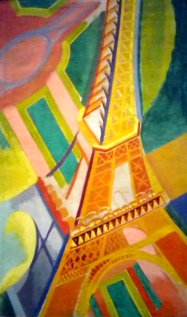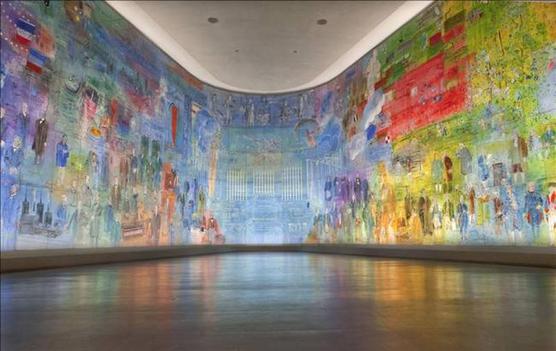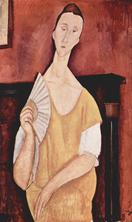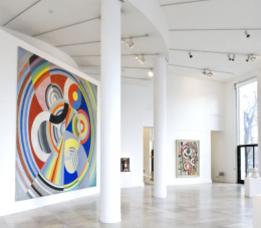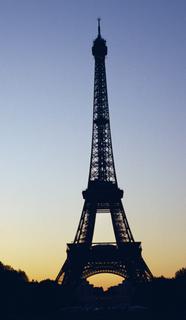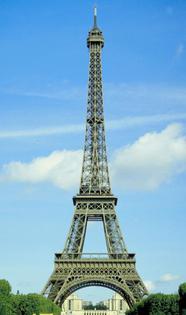Copyright 2017 Creative Travel Publications, LLC
The Bathers Albert Gleizes 1912
The Electric Fairy
Raoul Dufy 1937
The Eiffel Tower
Robert Delaunay
1915 - 1917
Symphony of Color
Robert Delaunay 1915 - 1917
I am trying, for a second time, to find the city of Paris Museum of Modern Art. The first time I tried it was cold and rainy. The bad weather discouraged me from looking very hard. However, this time it is a warm and sunny day in the city of lights.
The Palace of Tokyo is situated on the right bank of the Seine River. It was built in 1937 for the International Exhibition. The building was designed by the architects Dondel, Aubert, Dastugue, and Viard. The Museum of Modern Art is in the east wing of the Palace. It was opened as a free city museum in 1961.
The museum houses art from many modern movements - Fauvist, Dadaist, Surrealist, Cubist paintings and sculpture. The Paris School, realist, and abstract art is represented. I also find the decorative arts from the Art Decor to current times are on display here. There are paintings by many of the early modern artists like Henri Matisse, Pablo Picasso, Amedeo Modigliani, Andre Derain, Georges Braque, Fernand Leger, and Robert Delaunay. Artist works from later periods are also represented in the Etienne - Martin Collection, and Eugene Leroy.
Marie Curie
1867 - 1934
Woman with Fan
Amedeo Modigliani 1919
I take many photographs but because of copyright laws I can show you little of the art at this museum. Most of the art by women is so recent I am not able to reproduce it here. In the galleries, however, I find paintings by Sonia Delaunay (Rhythm-Color, 1964), Aurelie Nemours (Point of Commotion, 1971), Bridget Riley (Lilac Painting, 2003 - 2008), and photographs by Diane Arbus.
Rhythm
Robert Delaunay 1939
Walking into a large room I encounter an enormous mural covering a concave wall. The sheer size is amazing, easily 32 feet high (10 meters) and 195 feet wide (60 meters). The Electric Fairy was commissioned for the International Exhibition in 1937. It was painted on a similar wall in the Palace of Light and Electricity. On the lower part of the mural Raoul Dufy portrayed the history and application of electricity from its earliest times to the technical achievements up to 1937.
There are portraits of 110 great scientists and inventors who have made contributions to the development of electricity. Not wanting to spend time finding all of them I scan the mural for familiar names. I see, of course, many well-known men but only one famous woman. Nestled among them is the physicist Marie Curie. However, I have to look very close to see her because she has been painted with her back to me. Luckily her tan trench coat makes her a little more visible.
Somewhat disheartened by the painting I leave the museum. The sun is setting. Day has turned to night. I look across the Seine River and see the Eiffel Tower. The Eiffel Tower was built for the 1889 exhibition. Not very popular at the time it is now the single most recognized monument in the city of Paris.
Walking along the Seine I remember the Eiffel Tower is also decorated with the names of famous scientists and inventors. However, Eiffel did not include any women among them. As the tower lights up I think to myself, "It took almost forty years for one man to recognize just one of the many women scientists who have made their mark on history. I will take my beret goes off to you Raoul Dufy. One painting of a famous woman is better than none and later is better than never.
If you are coming to Paris from London on the Eurostar you can get a '2 for the price of 1' entrance ticket to all paying exhibitions. Simply show your Eurostar ticket. The offer is good up to five days after your arrival in Paris. Deals like this change often so please check the Eurostar website to make sure it is still offered.
The website for the City of Paris Museum of Modern Art (MAM) will give you visitors and exhibition information. Special cultural activities are available for adults, children, and the handicapped. The activities are in French and focus mostly on gallery tours, exhibition lectures, and teaching materials. A very interesting article about the architecture of the museum (l'architecture de musee d'art de la Ville de Paris) is available online (click on Cultural Resources, Online Resources, Teaching Materials). Written in French it has 11 pages about the architecture of the museum. It should be possible to use GOOGLE TRANSLATE to translate into just about any language.
The museum does have a library. It has a collection of catalogs for past exhibitions, contemporary art magazines, and artist books from 1960. The museum is open to researchers and students by appointment only. The library is currently being digitized on VIDEOMUSEUM and AGORHA under the MAM archives so you may be able to find some interesting articles on these websites.
I am having a difficult time seeing this building as a museum. There is trash on the steps, graffiti on statues, and very little water in the pool. Perhaps this building is abandoned and the museum moved. Maybe the museum is closed temporarily. I know the city of Paris often closes its museums for renovation.
I wonder if this is the most recent closing.
I walk up the steps and look around. To my surprise I find lots of activity at the top. Tables and chairs occupied by people of all ages. To my left I notice a lot of young people chatting or looking intently at open books. I think they might be students from the adjoining art school. On my right side I find the entrance door to the Modern Art museum.
The massive Art Nouveau bronze double-doors lead to a clean, spacious foyer. There is an indoor and outdoor restaurant, bookstore, and lounge in this area. I go to the counter and get a free ticket and brochure for the permanent collection. There is a temporary exhibition for a fee but I decide to spend my time here among the greatest masters of modern art in the permanent collection.
Looking at the brochure I notice the museum is on three floors. Each floor has a public restroom and lift (elevator). The museum is partially handicapped-accessible. The permanent collection is displayed in bright, expansive spaces with plenty of places to sit and ponder the art.
The brochure also tells me that as the collection grew, through donations and gifts, the original internal structure of the palace had to be altered to properly display the museum's vast collection. It was closed for several years but reopened in 2006 completely modernized. Since then the museum has gained a world-wide reputation for mounting large-scale installations.
Women's Travel Abroad
For Women About Women By Women
You Are Welcome to Contact Me Personally With Comments or Questions
Destinations
